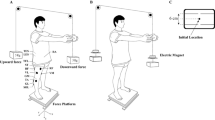Summary
The effect of the direction of unexpected horizontal perturbations of stance on the organization of automatic postural responses was studied in human subjects. We recorded EMG activity from eight proximal and distal muscles acting on joints of the legs and hip known to be involved in postural corrections, while subjects stood on an hydraulic platform. Postural responses to horizontal motion of the platform in 16 different directions were recorded. The amplitude of the EMG responses of each muscle studied varied continuously as perturbation direction was changed. The directions for which an individual muscle showed measurable EMG activity were termed the muscle's “angular range of activation”. There were several differences in the response characteristics of the proximo-axial muscles as opposed to the distal ones. Angular ranges of activity of the distal muscles were unipolar and encompassed a range of less than 180°. These muscles responded with relatively constant onset latencies when they were active. Proximo-axial muscles, acting on the upper leg and hip showed larger angular ranges of activation with bimodal amplitude distributions and/ or onset latency shifts as perturbation direction changed. While there were indications of constant temporal relationships between muscles involved in responses to perturbations around the sagittal plane, the onset latency relationships for other directions and the response amplitude relationships for all directions varied continuously as perturbation direction was changed. Responses were discrete in that for any particular perturbation direction there appeared to be a single unique response. Thus, while the present results do not refute the hypothesis that automatic postural responses may be composed of mixtures of a few elemental synergies, they suggest that composition of postural responses is a complex process that includes perturbation direction as a continuous variable.
Similar content being viewed by others

References
Buchanan TS, Almdale DPJ, Lewis JL, Rymer WZ (1986) Characteristics of synergic relations during isometric contractions of human elbow muscles. J Neurophysiol 56: 1225–1241
Diener HC, Dichgans J, Bootz F, Bacher M (1984) Early stabilization of human posture after a sudden disturbance: influence of rate and amplitude of displacement. Exp Brain Res 56: 126–134
Diener HC, Horak FB, Nashner LM (1988) Influence of stimulus parameters on human postural responses. J Neurophysiol 59: 1888–1905
Hoffman DS, Strick PL (1986) Activity of wrist muscles during step-tracking movements in different directions. Brain Res 367: 287–291
Horak FB, Nashner LM (1986) Central programming of postural movements: adaptations to altered support-surface configurations. J Neurophysiol 55: 1369–1381
Hoy MG, Zernicke RG (1985) Modulation of limb dynamics in the swing phase of locomotion. J Biomech 18: 49–60
Hoy MG, Zernicke RG (1986) The role of intersegmental dynamics during rapid limb oscillations. J Biomech 19: 867–877
Marsden CD, Obeso JA, Rothwell JC (1983) The function of the antagonist muscle during fast limb movements in man. J Physiol (Lond) 335: 1–13
McCollum G, Horak FB, Nashner LM (1985) Parsimony in neural calculations for postural movements. In: Bloedal J, Dichgans J, Pratt W (eds) Cerebellar functions. Springer, Berlin Heidelberg New York, pp 52–66
Moore SP, Rushmer DS (1987) Automatic postural responses of humans to horizontal perturbations of stance in different directions. North Am Soc Psychol Sport Phys Activity, Vancouver, BC
Moore SP, Horak FB, Nashner LM (1986) Influence of stimulus anticipation on human postural responses. North Am Soc Psychol Sport Phys Activity, Scottsdale, Arizona
Nashner LM (1977) Fixed patterns of rapid postural responses among leg muscles during stance. Exp Brain Res 30: 13–24
Nashner LM, McCollum G (1985) The organization of human postural movements: a formal basis and experimental synthesis. Behav Brain Sci 8: 135–150
Nashner LM, Woollacott M, Tuma G (1979) Organization of rapid responses to postural and locomotor-like perturbations of standing man. Exp Brain Res 36: 463–476
Rushmer DS, Russell CJ, Macpherson J, Phillips JO, Dunbar DC (1983) Automatic postural responses in the cat: responses to headward and tailward translation. Exp Brain Res 50: 45–61
Rushmer DS, Windus SL, Russell CJ (1986) Automatic postural responses in the hindlimb of the cat to horizontal perturbations of stance in different direction: variations in synergic organization. Symposium on neural control of limb movement. University of Washington, Seattle, pp A4
Rushmer DS, Macpherson JM, Dunbar DC, Russell CJ, Windus SL (1987) Automatic postural responses in the cat: responses of proximal and distal hindlimb muscles to drop of support from a single hind or forelimb. Exp Brain Res 65: 527–537
Rushmer DS, Moore SP, Windus SL, Russell CJ (1988) Automatic postural responses in the cat: responses of hindlimb muscles to horizontal perturbations of stance in multiple directions. Exp Brain Res 71: 93–102
Smith JL, Zernicke RF (1987) Predictions for neural control based on limb dynamics. Trends Neurosci 10: 123–128
Wells R, Evans Stuber N (1986) Electromyographic responses to the lower limb musculature in simulated postural and locomotor activities. North Am Congr Biomech, Montreal
Wierzbicka MM, Wiegner AW, Shahani BT (1986) Role of agonist and antagonist muscles in fast arm movements in man. Exp Brain Res 63: 331–340
Author information
Authors and Affiliations
Rights and permissions
About this article
Cite this article
Moore, S.P., Rushmer, D.S., Windus, S.L. et al. Human automatic postural responses: responses to horizontal perturbations of stance in multiple directions. Exp Brain Res 73, 648–658 (1988). https://doi.org/10.1007/BF00406624
Received:
Accepted:
Issue Date:
DOI: https://doi.org/10.1007/BF00406624



